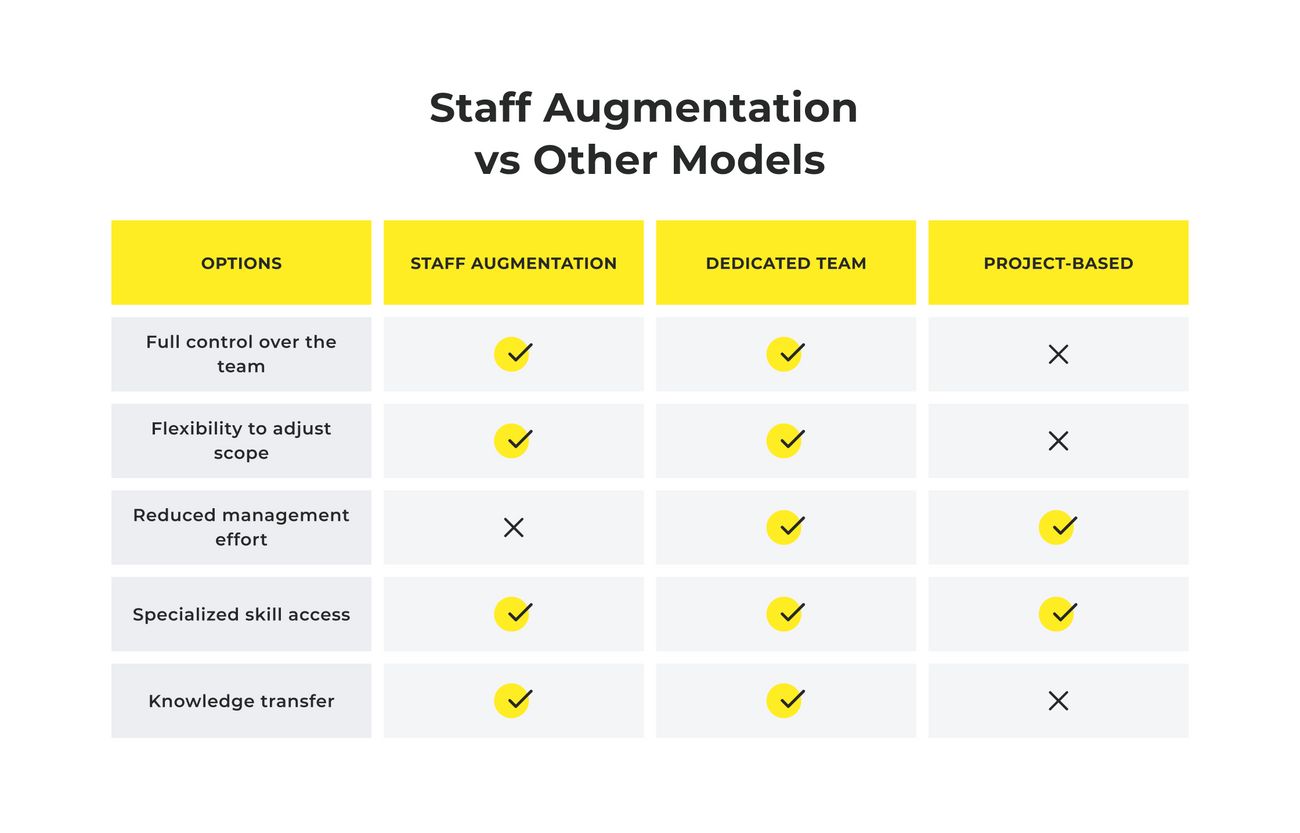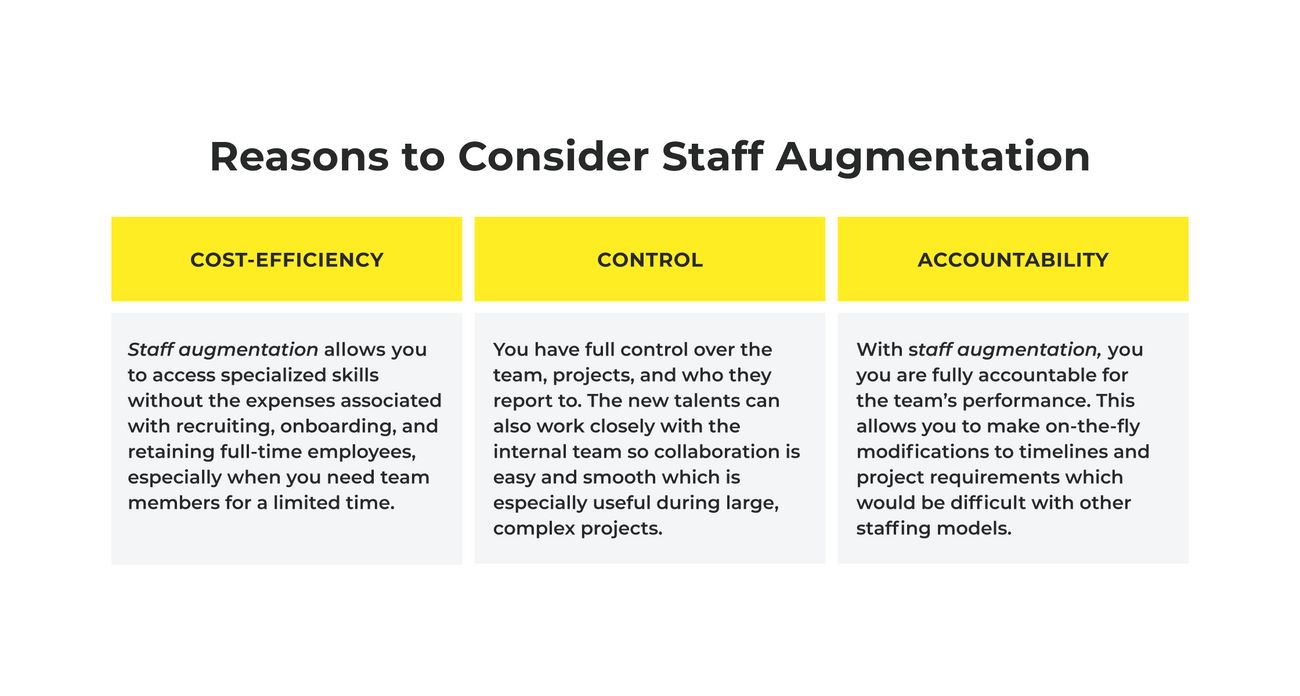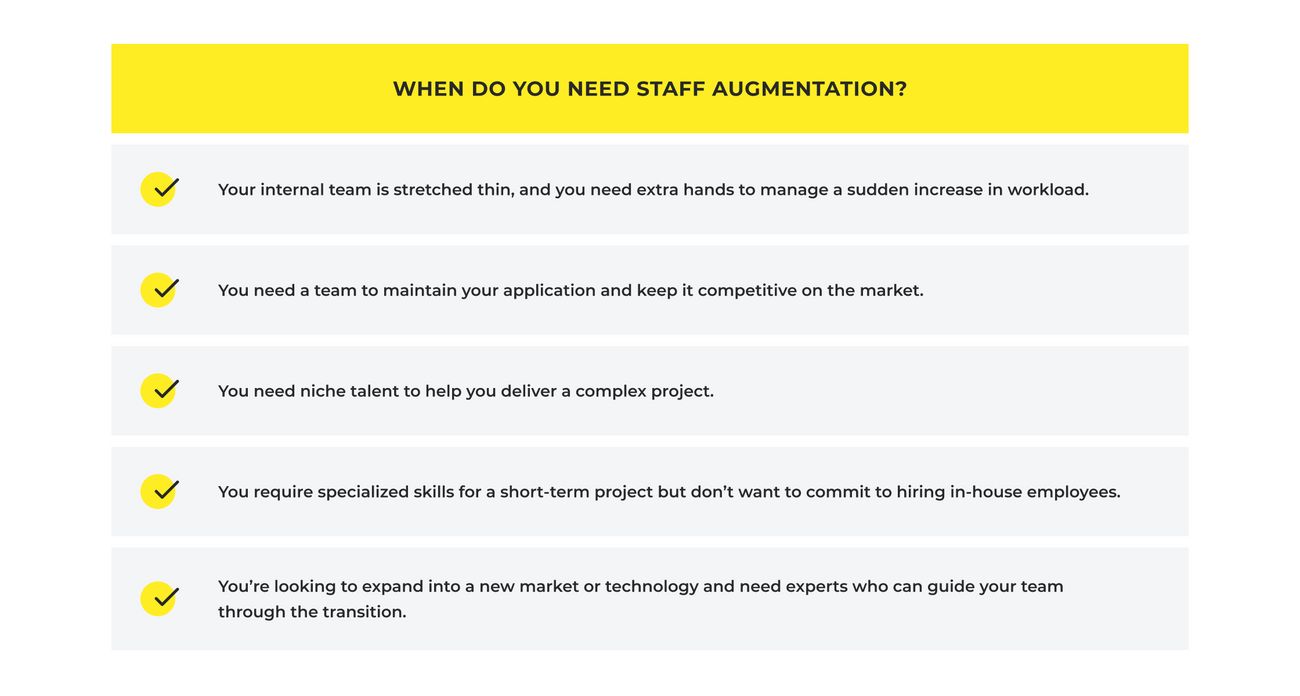The talent shortage has become a problem known to almost any business, whether it’s a growing startup or an enterprise. Three of every four employers report difficulties hiring the talent they need, with IT & data skills being the most challenging to find. How can companies solve this problem?
The main solution to the talent shortage is staff augmentation. It allows companies to find the right talent and deliver their projects on time without investing too much time and money in recruitment. But what exactly is staff augmentation and how can businesses adopt it to quickly and effectively find the right experts?
Read on to find out what staff augmentation is, how it works, and whether it’s the right engagement model for your business.
What is staff augmentation? Staff augmentation meaning and reasons for choosing
Staff augmentation is the process of expanding your existing team with temporary employees at a lower cost than hiring full-time employees. IT team augmentation allows companies to find external tech talents with the necessary skills and expertise to help them meet project requirements. Instead of committing to full-time hires, which could ramp up costs, businesses can tap into a bigger pool of specialized resources by partnering with an outsourcing company in a different region. The staff augmentation model helps companies accelerate project timelines and streamline operations by bypassing the time-intensive processes of recruitment, onboarding, and employee retention.
Working as an extension of an existing team, the augmented staff is managed directly by the company that hired them. Simply put, augmented employees act as an in-house staff but without the high costs and liabilities involved in hiring and retention.
Staff augmentation model vs. other outsourcing models
Outsourcing companies today offer different services so it’s easy to get confused about what you should choose for your project. As such, it’s important to distinguish between staff augmentation and the other outsourcing models. To help you see their main differences, we compared staff augmentation with project-based and dedicated team models.
Read also: In-house software development vs outsourcing
Project-based model vs. staff augmentation
In a project-based model, you delegate a project to an outsourcing company completely, from start to finish. You and the outsourcing company agree to a specific set of project parameters and determine the frequency of updates. In this staffing model, the outsourcing company provides a project manager, and this person is responsible for managing the project-based team’s workflow and ensuring that the final product is delivered on time and according to agreed-upon specifications.
With staff augmentation, on the other hand, you retain control over the project and manage the augmented staff directly. This means that you can make real-time adjustments and decisions as the project evolves. The augmented staff works as part of your team, allowing for better integration with your existing processes and greater flexibility in meeting project demands.
Dedicated team model vs. staff augmentation
By choosing a dedicated team model, you hire a team of experts from an outsourcing provider to work on your project full-time. As the name suggests, a dedicated team is fully committed to your project, operating as your in-house team. But unlike an in-house team, you won’t have to recruit developers, buy equipment, or worry about employee turnover—your outsourcing provider will cover everything for you.
In comparison, staff augmentation allows you to add external experts to your existing team. This model is a great fit if you want to hire experts on a short-term basis, but a dedicated team model would be a better option if you are looking for a long-term commitment.
To sum up, here’s the table with staff augmentation pros and cons compared to managed services and project-based models.

IT staff augmentation meaning for the business sector
If your business is considering outsourcing specific functions to a third party, there are three main reasons for augmenting your team.

Now, if you're still not sure if staff augmentation caters to your business needs, here are seven telltale signs you should consider it.
7 not-so-obvious signs you need IT staff augmentation
Some obvious signs you need IT staff augmentation is when you have tight deadlines and overwhelming workloads. However, there are also more subtle but equally important indicators that you could benefit from additional hands (and brains) on deck, which staff augmentation provides. Here’s a look at some less obvious indicators for bringing in some external tech talent—and why this could be your smartest move.
Budget constraints don't let you hire more talent
Let’s face it—hiring full-time talent is expensive. Salaries, benefits, and the ramp-up time all add up, especially when your margins are already reaching the limit. Staff augmentation gives you a way around this: you get the skills you need, when you need them, without the long-term financial commitment. It’s like renting the perfect skill set without the year-round lease.
To sum up, here’s the table with staff augmentation pros and cons compared to managed services and project-based models.
Your hiring pipeline is stuck in slow motion
We all know the value of finding the perfect in-house expert, but hiring can be a slow process. According to the iCIMS Workforce report, it takes an average of 41 days to fill an open role. When you need someone right now, those weeks spent recruiting, interviewing, and onboarding can feel endless. That’s where staff augmentation comes in, letting you quickly bring in the right skills to keep your projects on track without delay.
High employee turnover is disrupting your flow
We’ve all been there: you finally have a team that clicks, and then, bam—someone leaves. When turnover becomes a pattern, it’s not just an HR headache; it’s a project killer. Deadlines slip, morale dips, and the constant onboardings chew up your time. Bringing in augmented staff can keep your projects going, buying you time to fix internal issues.
Flexibility is key, but your team can’t stretch any further
One of the best things about running a lean and mean operation is agility. But what happens when you need to scale quickly, and your core team is already maxed out? Staff augmentation allows you to dial in the exact resources you need, exactly when you need them, without overburdening your team or risking burnout.
You want to experiment with new tech, but your team’s tapped out
Innovation is the name of the game, but it’s hard to be innovative when your team is slammed just keeping the lights on. You might have a great idea for exploring AI, blockchain, or a fresh tech stack, but who’s got the time? Bringing in temporary workers through staff augmentation lets you explore new avenues without losing focus on your bread-and-butter projects.
You’re expanding but not ready for full-time local teams
When you’re growing geographically, be it targeting a new region or launching a global product, you often need local expertise fast. Hiring full-time local talent is a massive investment, both financially and project management-wise. Staff augmentation gives you immediate access to on-the-ground talent without the long-term commitment.
Quality is slipping, and you can’t pinpoint why
Do any of these signs ring a bell? Then it might be time to consider staff augmentation. In the end, augmentation is not just about getting more hands on deck; it’s about the right hands at the right time to help you stay agile, maintain quality, and keep your projects moving.
Okay then, we’ve clarified when you need staff augmentation, so let’s now explore the key types of IT staff augmentation services.
What are the main types of staff augmentation?
To help you better understand the terminology in the field of staff augmentation, we’ve broken down the main types of services you might encounter. Different companies offer a variety of staff augmentation options, each suited to different needs. Here’s a quick guide to help you navigate these categories:
Commodity staff augmentation: This is your go-to when you simply need more hands on deck, without a focus on specific skills or expertise. It’s perfect for offloading repetitive tasks so your in-house team can stay focused on core responsibilities. This staff augmentation approach is all about urgency and efficiency, making it ideal when meeting deadlines is the priority over specialized skills.
Skilled staff augmentation: As the name suggests, this category covers professionals with a specific skill set necessary for particular roles or projects. While these individuals aren’t strategic experts, they bring the required skills and experience to get the job done, bridging gaps in your team without needing high-level expertise.
Highly skilled staff augmentation: When your project demands top-tier experts with specialized or rare skills, this staff augmentation option fits the bill. These professionals bring a depth of knowledge that not only handles complex tasks but also contributes to strategic decision-making, adding significant value beyond execution.
Now that we’ve covered that, let’s pass on to staff augmentation benefits.
Benefits of IT staff augmentation
The staff augmentation model offers several advantages that can give your business a competitive edge:
Reduced time-to-market. Augmenting your team with skilled professionals will not only help you meet deadlines but also allow you to accelerate your product’s time-to-market.
Knowledge transfer. With staff augmentation your existing team can learn from industry experts and gain valuable insights, improving their own skills and boosting the company’s overall capabilities.
Access to specialized skills. With staff augmentation, you gain immediate access to a diverse talent pool of professionals with specialized skills and expertise, be it developers, designers, project managers, or subject matter experts.
Cost-efficiency. Hiring and training new employees can be a time-consuming and costly process. Staff augmentation allows you to bypass these costs by bringing in experienced professionals who are ready to hit the ground running.
Flexibility and scalability. Your business needs can vary due to numerous factors, from market changes to law regulations. But with staff augmentation, scaling up or down is easier than ever. Whether you lack specific skills or just need extra team members to complete a task or project, an augmented team can help you with both — and at a fraction of the cost of hiring full-time employees.
So now that you understand the benefits of staff augmentation, it's also crucial to discuss how developers can be hired for your software development project.
Where do you go for IT staff augmentation services?
When you're looking for team augmentation services, there are a few great options out there, each with its own strengths depending on what you need. Here’s a quick rundown to help you find the right fit for your projects.
IT staff augmentation companies
IT staffing companies are your go-to when you need skilled or highly skilled staff augmentation services. Think of big players like Accenture, Capgemini, or Infosys—they have deep pools of talent and can quickly provide the right people to plug into their IT workforce. They’re great for when you need senior resources fast and want these resources to contribute to strategic decision-making and facilitate knowledge sharing.
On the flip side, smaller IT staffing firms like Kultprosvet offer a great alternative if you need skilled professionals for your in house development team without the hefty price tag. These companies might have a more modest talent pool, but they excel in providing personalized service, flexibility, and lower costs. Kultprosvet, for instance, focuses on quality and building close client relationships, ensuring you get top-tier talent without paying exorbitant hourly rates. These staff augmentation providers are perfect when you need a hands-on, adaptable partner who can work closely with your existing team.
But when choosing a vendor for staff augmentation, don’t overlook B2B Review Sites like Clutch.co and GoodFirms to do a little background check on companies offering staff augmentation services.
Online talent marketplaces
If we're talking about staff augmentation, online talent Marketplaces like Upwork, Toptal, Freelancer, and Guru provide access to a wide range of freelancers, making it easy to find the skills you need without teaming up with a staff augmentation partner. For engineering-specific talent, platforms like Turing, Andela, or Cloud Devs are fantastic because they focus on connecting you with top-tier developers.
Industry-specific forums
Exploring industry-specific forums and communities like GitHub and Stack Overflow is also a smart move to hire tech talent globally. These platforms let you see developers’ work in action and directly reach out to contributors whose skills align with your needs. It’s a great way to find passionate professionals who are engaged in their craft and might be open to contract work or new opportunities.
So now that you know almost everything there is to it about staff augmentation, let’s see whether this model is for you.
Is staff augmentation model for you?
As said, there are multiple benefits to augmenting your team, but it all boils down to what fits your current business needs. Here are the main scenarios when staff augmentation will be the right choice:

In such cases, opt for staff augmentation and get access to the IT workforce in the shortest terms.
Bottom line
The staff augmentation model offers businesses quick and cost-efficient solutions to the common problem of talent shortage. The main challenge is to find an outsourcing partner that will help you find the right team members for your project.
When choosing a partner for staff augmentation, consider their experience in your industry, their reputation for delivering quality work, and their ability to adapt to clients' specific needs. At Kultprosvet, we successfully built five new dedicated teams and managed over 30 projects this year, helping companies deliver high-quality products in short timeframes. We help companies of all sizes hire top talent without any legal fuss or costly recruiting agency fees.
If you need to expand your team with skilled tech talents or fill specific skill gaps through staff augmentation, contact us and we’ll see how we can support your project.
